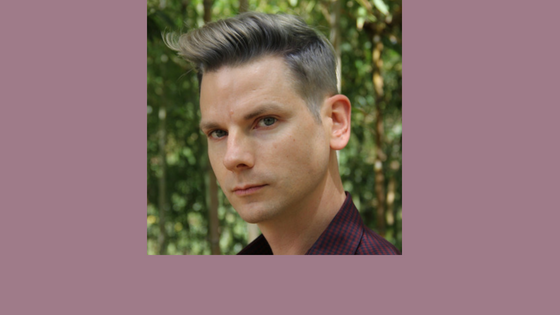Caleb Roehrig on Representation, Stealing Books From His Mom, and Writing Unlikeable Characters

Caleb Roehrig’s twisty White Rabbit centers around high school sophomore Rufus Holt, who’s thrust into the role of amateur detective when his hard-partying half-sister awakes next to the corpse of her boyfriend and enlists Rufus to clear her name. Complicating matters is that Rufus’ ex-boyfriend, Sebastien, has chosen the exact same night to try to reconcile after their tumultuous break-up a month earlier. For the next several hours, Rufus and Sebastien attempt to get to the bottom of the murder, bumping up against vicious classmates, tyrannous drug dealers, and an insidious new designer drug wrecking havoc on the community. Publishers Weekly gushed that Roehrig “nails the angst of spending time with an ex that you can’t help but love, as well as the heartache and confusion of coming out,” and Booklist raved that Roehrig “deftly weaves together thrills, intrigue, and fast-paced action in this delectable murder mystery.” Roehrig spoke to Brendan Dowling via e-mail on May 11, 2017.
The book starts with a quote from Sir Arthur Conan Doyle; who were the mystery authors who were influential to you as a writer?
One of my first influences was the great Agatha Christie. I read And Then There Were None in high school, and it completely blew my mind. For a long time afterward, however,
I had this unfortunate idea that a good mystery required a cast of wealthy aristocrats and
clues that were totally impenetrable. It wasn’t until I started swiping paperbacks from my
mom—by writers like Mary Higgins Clark and Patricia Cornwell—that I became exposed to
contemporary thrillers, and really fell in love with the genre. But if I had to name one single
author who made me want to sit down and write, it was Sue Grafton. Her mysteries were
compelling and direct, her characters complex and layered, and her writing was
atmospheric but accessible. Her alphabet series is what made me finally want to try my
hand at novels.
The book’s plot feels like a modern-day Raymond Chandler mystery, where we follow the gumshoe over the course of a night as he interviews suspects, although this time it’s complicated by the fact that the detective is in high school and he’s joined by his ex-boyfriend. How were you able to strike the balance of solving the murder while still paying attention to the very real love story at the center of the book?
Over time, I’ve found that love stories are my absolute favorite B-plot for a mystery.
Romance is a perfect counterpoint to a life-or-death narrative, because in love the stakes
can feel exactly that high; and shifting the focus from the mystery to the romance and back
again is a great way to increase tensions across the board. Also, since I write about gay
teenagers, it’s very important to me that I explore that part of their lives on the page. It’s
representation I was denied when I was a teenager, and I want young people who are
coming of age now to read this book and never doubt that they can be heroes, too.
One of the many factors that heighten the tension in the book is Rufus’s hair-trigger temper, and the fact that his past violent outbursts have caused him to be nearly expelled from school. What was compelling to you about a character who was at times at the mercy of almost uncontrollable emotions?
Prior to this book, I’d never tried to write a character who was governed by anger. Most of
my protagonists have been firmly “likable” in the traditional sense—friendly, forgiving,
self-deprecating—and I’ve recently come to realize that some of my favorite fictional
characters are the opposite. In fact, Rufus was mainly inspired by Sara Paretsky’s legendary
private detective V.I. Warshawski—a stubborn, irascible, and reactionary figure, whose
quick temper is part of what makes her so intriguing. I wanted to create a protagonist like
that, who could be angry first and friendly later, and whose journey between those two
emotions a reader would wish to explore.
The book’s setting in Lake Champlain plays a big role, and the environment takes on a menacing quality as the story progresses. What made this seemingly idyllic town the ideal location for your story?
I’ve always been drawn to small, seemingly perfect towns as a backdrop for mysteries.
From Agatha Christie’s Miss Marple books to “Twin Peaks,” the theme of ugliness lurking
just beneath the surface of an intimate community—where everybody knows everybody’s
business—is irresistible to me. In White Rabbit, the setting also echoes circumstances in Rufus’s life, where he finds himself trapped in a fishbowl with a tight-knit crew of popular
kids whose beautiful facades mask rotten truths.
While there have been murder mysteries set in high school in the past, White Rabbit feels different with its attention to class differences and the economic pressure Rufus and his mom are under. Can you talk about what went into creating the affluent yet violent world these characters inhabit?
It kind of turns out, I’ve discovered after writing a handful of manuscripts now, that classism is a recurring theme in my work. The wealth gap is a pretty stark and inescapable divide, and when you’re young it means the difference between being able to participate in popular trends or being on the outside. Status is an easy and convenient weapon for teenagers, and I’m generally more interested in telling stories from the point of view of the Have Nots. Unfairness of circumstance offers additional challenges to a character’s environment, and makes their journey more interesting, in my opinion.
The ending of the book seems to leave open the possibility that there are more mysteries for Rufus to solve. Will we see more books with Rufus and Sebastien?
I hope this doesn’t sound coy, but I’m not sure yet. Initially, I intended White Rabbit to be
a standalone, but as I completed it, I saw an avenue for a potential follow-up. However, the
story is a contained arc, so unless readers ask for more of these characters, I don’t know if
I’ll pursue it as a series.
What role has the public library played in your life?
Public libraries have played a huge role in my life! We went once a week when I was a kid,
and I would check out exactly as many books as the limit allowed. I’ve always had a huge
appetite for reading, and browsing library shelves is how I discovered writers like Sharyn
McCrumb and Iris Johansen; libraries are where I found Sara Paretsky’s Indemnity Only
and Kelley Armstrong’s Otherworld series; and as a writer I’m grateful that they
provide a resource for disadvantaged readers—and readers who, for many reasons, don’t
feel safe being seen purchasing a book with a gay protagonist. It means a lot to me.
Tags: Caleb Roehrig












